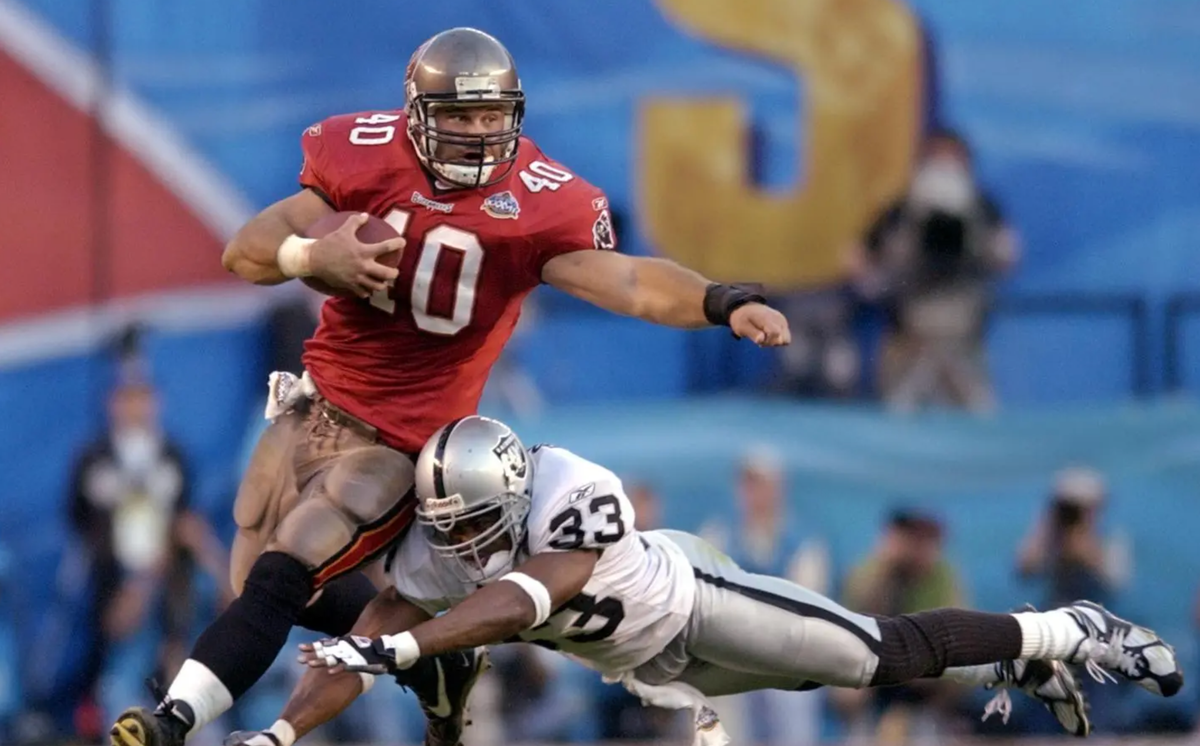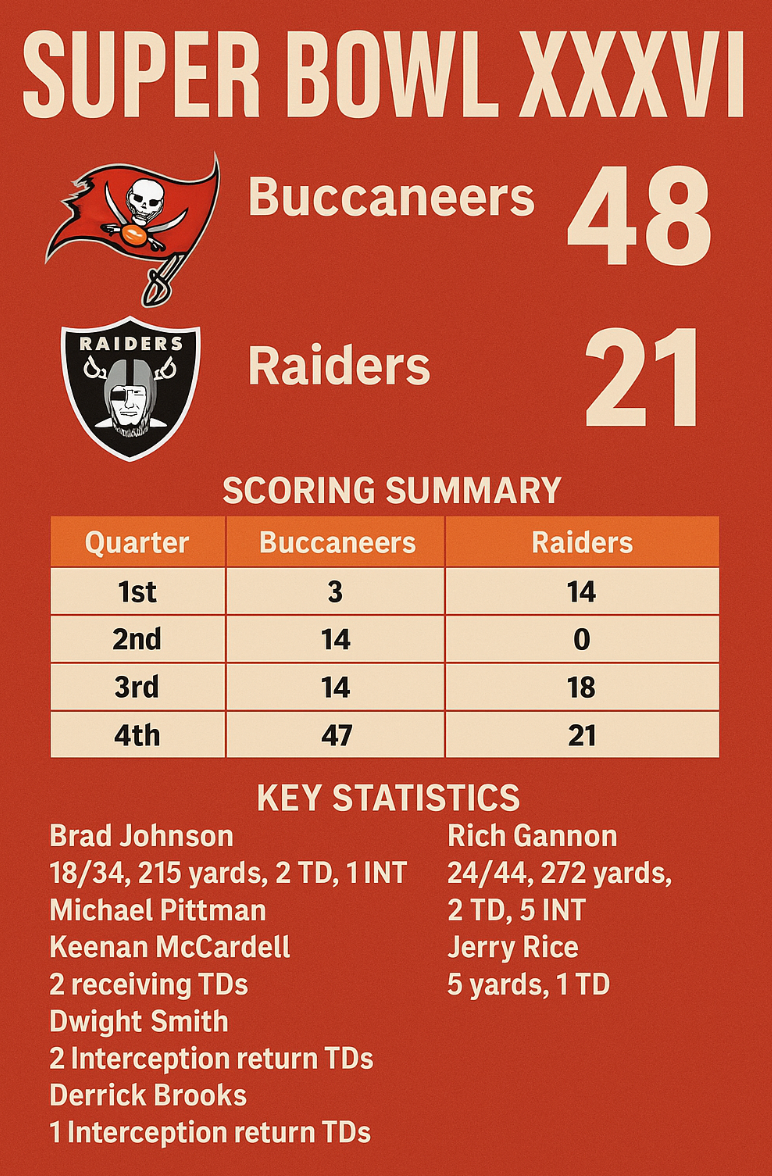Super Bowl XXXVII: The Buccaneer

On January 26, 2003, the NFL witnessed a defensive masterpiece and a long-awaited coronation. Super Bowl XXXVII wasn’t just another championship—it was the culmination of years of defensive dominance by the Tampa Bay Buccaneers, finally validated under the bright lights of Qualcomm Stadium in San Diego. In a game filled with narrative weight, ironic twists, and a masterclass in preparation, the Buccaneers outgunned the Oakland Raiders, 48-21, in one of the most lopsided—and revealing—Super Bowl blowouts of the modern era.
Setting the Stage: Two Teams with Very Different Journeys
The matchup between the Raiders and Buccaneers carried layers of complexity. On the surface, it was the classic case of the NFL’s top-ranked offense meeting the league’s top-ranked defense. But below that, it was a clash between teacher and student. The Raiders were led by head coach Bill Callahan, but the fingerprints on the offense still belonged to Jon Gruden, who had left Oakland just a season earlier to become Tampa Bay’s head coach. He brought with him an intimate knowledge of the Raiders’ playbook, personnel, and tendencies.
The Buccaneers, long known as a franchise mired in mediocrity, had transformed over the past few seasons. With a historically stout defense led by Hall of Famers like Derrick Brooks, Warren Sapp, John Lynch, and Ronde Barber, Tampa Bay was ready to make good on years of defensive promise. The only question was whether their newly installed West Coast offense, led by quarterback Brad Johnson, could score enough points to support that defense.
First Half: A Barrage of Buccaneer Brilliance
From the outset, the Buccaneers looked faster, more aggressive, and more prepared. Their defense swarmed the Raiders' receivers and pressured quarterback Rich Gannon, the 2002 NFL MVP, into hurried throws and panicked decisions. The Bucs’ defensive line collapsed the pocket repeatedly, while their linebackers and secondary jumped routes with uncanny precision.
Tampa Bay scored first on a 31-yard field goal by Martin Gramatica, and followed up with a 2-yard touchdown pass from Brad Johnson to Mike Alstott. By the time the first half ended, the Buccaneers had built a commanding 20–3 lead. Oakland’s usually potent offense, which had averaged 28 points per game in the regular season, was utterly flummoxed.
According to the Super Bowl Historical Society, “No team in Super Bowl history had ever executed a defensive game plan with such clairvoyance. It was as if the Buccaneers were in the huddle with the Raiders.” That wasn’t just hyperbole—Jon Gruden had prepared his team with the Raiders’ own play calls and tendencies. It showed.
Second Half: Defensive Dominance Reaches Historic Levels
The second half descended into a rout. Gannon was picked off not once, not twice, but five times—three of which were returned for touchdowns. Two of those came courtesy of Dwight Smith, whose pair of pick-sixes sealed the deal and set a Super Bowl record.
Derrick Brooks, the emotional and tactical leader of the Bucs’ defense, added another defensive touchdown on a 44-yard interception return with just under two minutes left in the game. His play embodied everything about this Tampa Bay unit—speed, anticipation, and killer instinct.
Meanwhile, Brad Johnson played mistake-free football, throwing for 215 yards and two touchdowns, and distributing the ball to Keenan McCardell (2 TDs) and Joe Jurevicius, whose big catches kept drives alive. Running back Michael Pittman added 124 yards on the ground, softening the Raiders’ interior and controlling the clock.
At one point, the score reached 34–3, before the Raiders added a few cosmetic points late. Final score: Buccaneers 48, Raiders 21.

Jon Gruden’s Revenge and the Irony of Familiarity
In one of the most ironic twists in Super Bowl history, Jon Gruden beat the team he had built using the very blueprint he left behind. His inside knowledge of the Raiders’ audible system was so detailed that Tampa defenders knew what play was coming on multiple occasions.
As the Super Bowl Historical Society notes, “Super Bowl XXXVII was football’s version of poetic justice. Gruden didn’t just outcoach the Raiders—he out-scripted them. It was the rare case where one team knew the other team’s script better than they did.”
Gruden became the youngest head coach to win a Super Bowl at the time, at age 39, and he did it by using the Raiders’ past to carve out the Buccaneers’ future.
Legacy and Historical Significance
1. One of the Greatest Defenses Ever
Tampa Bay’s 2002 defense is now considered one of the greatest in NFL history. They led the league in points allowed (12.3 per game), yards allowed, and interceptions. And they capped it off by scoring three touchdowns in the Super Bowl.
Brooks would later win Defensive Player of the Year, Sapp would continue his path to the Hall of Fame, and the Tampa 2 defensive scheme—innovated by Tony Dungy and perfected by Monte Kiffin—would be copied league-wide for years.
2. A Harsh Fall for Oakland
Despite their dominant regular season, the Raiders would not recover. Rich Gannon never returned to MVP form. The team aged quickly and entered a spiral that lasted more than a decade. Super Bowl XXXVII marked the last time the Raiders appeared in a Super Bowl—at least as of 2025.
3. Gruden’s Legacy Cemented
Though Jon Gruden’s later years with the Raiders (and his controversial exit from coaching) would cloud his reputation, his game plan for Super Bowl XXXVII remains a coaching clinic in preparation and execution.
Key Statistics
Tampa Bay Buccaneers
- Brad Johnson: 18/34, 215 yards, 2 TD, 1 INT
- Michael Pittman: 29 carries, 124 yards
- Keenan McCardell: 2 receiving TDs
- Dwight Smith: 2 INT return TDs
- Derrick Brooks: 1 INT return TD
- Total Team Turnovers Forced: 5 INTs, 1 fumble recovery
Oakland Raiders
- Rich Gannon: 24/44, 272 yards, 2 TD, 5 INT
- Jerry Rice: 5 receptions, 77 yards, 1 TD
- Tim Brown: 1 reception, 9 yards
Final Thoughts
Super Bowl XXXVII was more than just a championship—it was a clinic in preparation, a redemption story for an oft-mocked franchise, and the final chapter in one team’s long build toward greatness.
It wasn’t decided by a miraculous catch or last-second field goal. Instead, it was a methodical dismantling, carried out by a team that had heard for years they couldn’t win when it mattered most.
On that January night in San Diego, the Tampa Bay Buccaneers not only proved their doubters wrong—they changed the narrative of franchise history forever.
